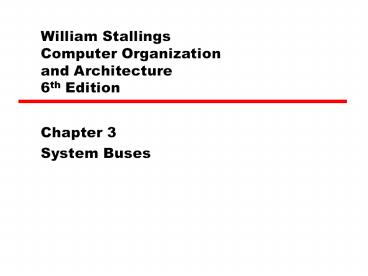William Stallings Computer Organization and Architecture 6th Edition - PowerPoint PPT Presentation
Title:
William Stallings Computer Organization and Architecture 6th Edition
Description:
William Stallings Computer Organization and Architecture 6th Edition Chapter 3 System Buses – PowerPoint PPT presentation
Number of Views:565
Avg rating:3.0/5.0
Title: William Stallings Computer Organization and Architecture 6th Edition
1
William Stallings Computer Organization and
Architecture6th Edition
- Chapter 3
- System Buses
2
Program Concept
- Hardwired systems are inflexible
- General purpose hardware can do different tasks,
given correct control signals - Instead of re-wiring, supply a new set of control
signals
3
What is a program?
- A sequence of steps
- For each step, an arithmetic or logical operation
is done - For each operation, a different set of control
signals is needed
4
Function of Control Unit
- For each operation a unique code is provided
- e.g. ADD, MOVE
- A hardware segment accepts the code and issues
the control signals - We have a computer!
5
Components
- The Control Unit and the Arithmetic and Logic
Unit constitute the Central Processing Unit - Data and instructions need to get into the system
and results out - Input/output
- Temporary storage of code and results is needed
- Main memory
6
Computer ComponentsTop Level View
7
Instruction Cycle
- Two steps
- Fetch
- Execute
8
Fetch Cycle
- Program Counter (PC) holds address of next
instruction to fetch - Processor fetches instruction from memory
location pointed to by PC - Increment PC
- Unless told otherwise
- Instruction loaded into Instruction Register (IR)
- Processor interprets instruction and performs
required actions
9
Execute Cycle
- Processor-memory
- data transfer between CPU and main memory
- Processor I/O
- Data transfer between CPU and I/O module
- Data processing
- Some arithmetic or logical operation on data
- Control
- Alteration of sequence of operations
- e.g. jump
- Combination of above
10
Example of Program Execution
11
Instruction Cycle - State Diagram
12
Interrupts
- Mechanism by which other modules (e.g. I/O) may
interrupt normal sequence of processing - Program
- e.g. overflow, division by zero
- Timer
- Generated by internal processor timer
- Used in pre-emptive multi-tasking
- I/O
- from I/O controller
- Hardware failure
- e.g. memory parity error
13
Program Flow Control
14
Interrupt Cycle
- Added to instruction cycle
- Processor checks for interrupt
- Indicated by an interrupt signal
- If no interrupt, fetch next instruction
- If interrupt pending
- Suspend execution of current program
- Save context
- Set PC to start address of interrupt handler
routine - Process interrupt
- Restore context and continue interrupted program
15
Transfer of Control via Interrupts
16
Instruction Cycle with Interrupts
17
Program TimingShort I/O Wait
18
Program TimingLong I/O Wait
19
Instruction Cycle (with Interrupts) - State
Diagram
20
Multiple Interrupts
- Disable interrupts
- Processor will ignore further interrupts whilst
processing one interrupt - Interrupts remain pending and are checked after
first interrupt has been processed - Interrupts handled in sequence as they occur
- Define priorities
- Low priority interrupts can be interrupted by
higher priority interrupts - When higher priority interrupt has been
processed, processor returns to previous interrupt
21
Multiple Interrupts - Sequential
22
Multiple Interrupts Nested
23
Time Sequence of Multiple Interrupts
24
Connecting
- All the units must be connected
- Different type of connection for different type
of unit - Memory
- Input/Output
- CPU
25
Computer Modules
26
Memory Connection
- Receives and sends data
- Receives addresses (of locations)
- Receives control signals
- Read
- Write
- Timing
27
Input/Output Connection(1)
- Similar to memory from computers viewpoint
- Output
- Receive data from computer
- Send data to peripheral
- Input
- Receive data from peripheral
- Send data to computer
28
Input/Output Connection(2)
- Receive control signals from computer
- Send control signals to peripherals
- e.g. spin disk
- Receive addresses from computer
- e.g. port number to identify peripheral
- Send interrupt signals (control)
29
CPU Connection
- Reads instruction and data
- Writes out data (after processing)
- Sends control signals to other units
- Receives ( acts on) interrupts































